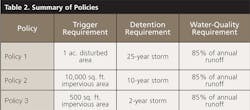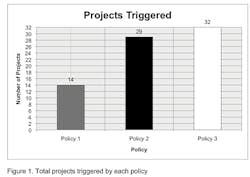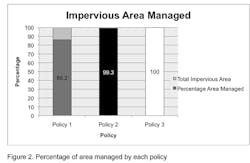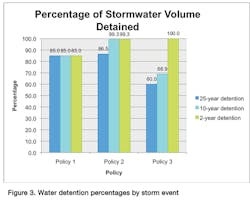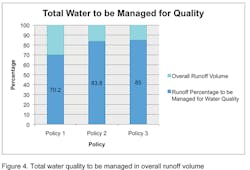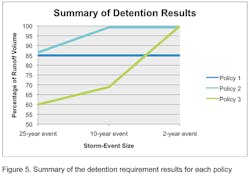An Approach for Communities to Assess Stormwater Application and Detention Requirements for Overall Watershed Health
Communities, especially those with limited resources, face many issues when trying to protect their local watersheds through the use of stormwater policies. Stormwater policies that are imposed on new development have the ability to enhance a community’s overall watershed health (Ferguson 1998). However, past requirements often relate only to large sites and require large detention facilities, which focus on flood protection, and disregard smaller sites and smaller rain events altogether. This approach does not reflect the end goal of a more sustainable stormwater design that mimics the natural hydrologic processes (Freni et. al 2010).
Stormwater management policies are considered most effective when they can successfully collect, convey, manage, and treat the majority of stormwater runoff from the greater part of a community’s urban environment (Ferguson 1998). Ultimately, by effectively managing a greater volume of stormwater runoff, a greater prevention of flooding may be achieved while still maintaining a high quality of water runoff. Through the evolution of stormwater management, more sustainable development techniques have emerged that primarily focus on onsite infiltration and pollution control of stormwater runoff (Deebo and Reese 2003). These techniques encourage stormwater policy development to include management that is smaller and closer to the source, capable of handling multiple storm events, and that treats water quality as well as runoff quantity (USEPA 2009).
With various past precedents and new concepts for stormwater management, municipal policymakers are left with the difficult task of deciding which policy can best meet their unique needs for overall watershed protection. The purpose of this study is to present a simple policy selection process to help communities develop an onsite stormwater management approach that balances overall watershed protection with local development practices. This study addresses these issues by testing a range of onsite stormwater management policies against a list of previous and existing development projects from a small community. The community in question, Starkville, MS, has limited access to designers and developers with experience in more sustainable stormwater management. At the time this study took place, the city had recently adopted a detention requirement for new development but was not currently under the National Pollutant Discharge Elimination System (NPDES) Phase II (Starkville 2010). This city is the ideal location for this study because both the city engineer, and other government officials are eager to restructure their current stormwater ordinance to include more sustainable requirements for onsite stormwater management of smaller development projects.
As stormwater policy requirements are usually quite detailed in the specific requirements of both runoff volume, and pre- and post-development site conditions, this study limits the major policy elements being tested to three categories. These categories are: the application trigger, overall detention requirement, and water-quality requirement. Based on the results, recommendations are offered on which policy combinations work best for the community studied and how other communities can use a similar process.
Aspects of an Onsite Stormwater Management Policy
There are three key variables of an onsite stormwater policy. These include: the application trigger, detention requirements, and water-quality requirements. A project’s application trigger refers to the total amount of disturbed area allowed before stormwater management requirements must be met (BES 2008). A stormwater detention requirement refers to the size of storm event or rainfall intensity a facility must accommodate. Detention requirements also vary from city to city. Stormwater quality in a policy deals with runoff pollutants that interfere with the natural and biological processes of a water body (BES 2008). These pollutants include soil sedimentation, heavy metals, significant amounts of nutrients, bacteria, litter, and organic materials (oil, fertilizer, etc.; BES 2008). Pollution reduction policies require a development to reduce the amount of these pollutants. Each municipality has a different application requirement to meet; however, most follow EPA’s minimal requirement conditions (USEPA 2009).
Basic Modeling Inputs
Each stormwater runoff modeling approach incorporates a variety of inputs required for calculations. However, there are three basic inputs that can be found in each method: intensity (storm event), rainfall frequency (size of event managed), and runoff coefficient (or the surface characteristics). A storm event is measured by the rainfall intensity. Rainfall intensity is the rate at which rain falls onto a surface and can be measured in inches per hour; it is selected over a period of time that is determined by the duration and the frequency of rainfall (Mays 2004). Rainfall frequency refers to the amount of time in between storm events of a given magnitude or the size of the event (Ferguson 1998). The size and scale of a storm differs from area to area depending on the region’s climate.
Each region has a reoccurrence interval that determines the amount of volume that occurs from each storm event (NOAA 2011). The storm events are expressed as one-year, 10-year, 25-year, etc. A site’s surface characteristics can be determined by the time of concentration (TOC) and the runoff coefficient. TOC refers to the largest amount of time it takes for water to flow from the farthest point in a drainage area to an outlet source (Ferguson 1998). The surface on which that runoff travels determines what the runoff coefficient will be. The runoff coefficient is an empirical-constant value that represents the amount of rainfall that will eventually result in runoff (USEPA 2009).
Methods
Data Collection. The city of Starkville, MS, was chosen for this research because of its representation of a small southern city in the United States, its ideal proximity to the Mississippi State University, and its project data availability. The city is currently not under NPDES Phase II, but has recently adopted a detention requirement for new development. The results of this study were provided to the city of Starkville to help it better refine its current stormwater ordinance.
Data Set. The projects collected for this research are representative of a three-year period of new development for the years 2009–2011 (Table 1). A total of 38 projects were constructed and went through the city’s site plan approval; however, only 35 of the projects provided sufficient data to be included in the research. This offered a total sample data of 92% over a recent three-year period, presenting a defensible set of data. The years of 2009, 2010, and 2011 were selected due to their currency and complete project data sets. It was felt that three years, rather than one year, provides a more accurate window of the types of development that occur in the city and helps to avoid trends in development.
Some of the projects were required to use a new ordinance for stormwater management; however, in order to maintain a baseline of measurement, this was not taken into consideration while measuring the individual policies. Within the data set, there is a range of sizes, with several large outliers. The land use for each project varied from commercial to residential, with the majority being commercial. The project types varied from condos to subdivisions and restaurants.
A limitation with the data set provided by the city of Starkville was that it was only a representation of building that exceeds 1,000 square feet in area. The new construction project list used in this study did not include any of the sites with less than 1,000 square feet of impervious surface. Those projects required only a building permit and did not need to submit plans for a review process, therefore making the required data for this study unavailable. This is a technical issue with the administrative process that may have made a significant difference in the study, especially concerning the comparison of total projects triggered into the equation.
Policy Development. As stated previously, the purpose of this study is to compare a range of stormwater policies against a series of new development projects to determine which policy best meets a community’s watershed needs. This study looks at three critical components of a stormwater ordinance: application trigger, detention requirement, and water-quality requirement (Table 2).
- The application trigger describes which projects have to meet the requirement.
- The detention requirement determines how much detention each site must provide.
- The water-quality requirement determines the total volume of water that needs to be cleaned.
Policy 1: 1-Acre, 25-Year Event. The first policy chosen for the study requires a 1-acre disturbed area trigger with a 25-year event detention requirement. The 1-acre trigger is what is currently required under NPDES Phase II (USEPA 2009). It is widely considered to be a baseline trigger for many municipalities, and it is for this reason that it was selected to be the trigger for the first policy. A large detention requirement can range from a 25-year to a 100-year detention requirement. Atlanta, GA, which has a 25-year detention requirement, was used as the precedent for this policy (AMEC 2001; Debo and Reese 2003).
Policy 2: 10,000-Square-Foot, 10-Year Event. The second policy was determined to be the one that was “in the middle” of Policy 1 and Policy 3. It calls for a 10,000-square-foot impervious area trigger and a 10-year detention requirement. These two requirements are a relative average in stringency according to recent stormwater policies (Debo and Reese 2003). The city of Philadelphia, PA, uses a detention requirement similar to this of 15,000 square feet of disturbed area (PWD 2009, Landers 2009).
Policy Detention Results. From the 14 projects triggered by Policy 1, a relatively low amount of detention was provided for the 25-, 10-, and 2-year storm events (Table 4). Policy 1 had the largest detention requirement; however, due to the limited number of projects that were triggered into the calculation, it provided the smallest number of detention facilities of the three policies. For all the policies tested, Policy 2 provided the greatest amount of detention. Although Policy 3 maintained the most detention for the 2-year storm-event, it provided the least detention for the 25- and 10-year storm-events even though it triggered the greatest number of projects into the calculation (Figure 3).
Policy Water-Quality Results. Of the total volume of annual runoff for all 32 projects (17,389,508.6 cubic feet), Policy 1 provided the least amount to be managed (Table 5). Because there were only two projects not triggered into Policy 2, it implemented 1.2% less than 85% of runoff required, thus providing the second-highest percentage of runoff to be managed. Policy 3 provided the highest runoff percentage to be managed for water quality and was the only policy to meet the full 85% annual runoff requirement (Figure 4).
Discussions and Conclusions
Discussion of the Policy Results. The results of this study provide a comparison of three separate policies and the volume of stormwater runoff managed by each (Table 6). These policies were selected to determine which one could be adopted by the city of Starkville and manage the greatest amount of stormwater runoff. Each policy presented its own unique successes and failures when applied to Starkville’s conditions and requirements.
Policy 1 had the smallest amount of total impervious area managed and a relatively average volume of detention to be managed, due to the large trigger requirement (Figure 5). In order for Policy 1 to manage a larger percentage of impervious area and a greater volume of runoff, it must decrease its trigger size to better reflect the size of new development that is being constructed. Policy 1 also managed the least annual runoff for water quality. This is a direct result of the trigger failing to generate a substantial amount of projects into the calculation to meet the requirement. If it had a smaller trigger that was more representative of the new development of the area, it would have been able to provide a greater scope of stormwater runoff management to a higher degree of water quality.
Policy 2 managed the greatest volume of stormwater runoff and had the most accurate trigger requirement for impervious surface size of the projects tested. In the categories that it did not achieve the greatest volume of runoff managed, Policy 2 had the smallest margin of difference to that of the leading policy. It also had high volume of stormwater runoff to be managed for water quality according to the conditions of community it was tested against. Of the policies measured in this research, this policy is the most ideal solution to meet the needs of Starkville. However, given that this policy was tested against the specific conditions of Starkville, it may not be ideal for another community with projects that are greater than 10,000 square feet and with larger rain events. This policy may be an appropriate approach for smaller municipalities that occur in more suburban areas with a relatively smaller population.
Policy 3 had the most stringent trigger requirement and detention requirement. In most urban communities, Policy 3 will manage the greatest amount of impervious area, given the relatively small project sizes. However, because the median impervious area for the projects in Starkville is 48,096 square feet, the 500-square-foot trigger may be a little excessive for the size of new development occurring in this particular area. This policy also had a small volume of stormwater runoff to be managed compared to the other two policies. Policy 3 also had the highest volume of water to be treated for quality, due to the policy’s trigger allocating 100% of surface area to be managed. This policy would be best suited for urban communities where new construction impervious area is similar to 500 square feet and that have smaller rain events, such as Portland, OR.
Starkville’s Policy Results. After the three policies discussed in this research were tested, the city of Starkville’s current stormwater management policy was then tested and measured against the other policies. The requirements of Starkville’s policy state that any new development or redevelopment that is at least 1 acre, but less than 2 acres, and that has 50% or greater impervious surface must provide stormwater management, thus triggering 19 of the 32 total projects into the calculation. Due to the small number of projects triggered into the calculation, Starkville’s policy allocated the second-smallest total impervious surface to be managed, after Policy 1 (Table 7). The city’s policy also provided the smallest volume of runoff to be managed according to the detention requirements (Table 8).
The city of Starkville’s policy does not have a water-quality requirement, so stormwater runoff is not treated for any water-quality requirements.
Starkville’s policy was the most similar to Policy 1 in that it designated stormwater management for a relatively small area of new development with a lower volume of runoff to be managed. It would have been more successful in managing a greater area of impervious surfaces by decreasing the trigger requirement to provide more projects with greater stormwater coverage. With these results, it may be surmised that the city’s current policy is not successfully meeting the needs of the community and watershed, based on the projects being constructed in the area. Policy 2 would manage a greater volume of water at a higher quality than Starkville’s current policy, thus providing a greater opportunity to better meet the needs of the community and surrounding watershed.
Recommendations. Based on the results of this study, several recommendations can be made for the city of Starkville’s stormwater management policy and for future development of stormwater policies in general. In order to determine the accurate trigger and detention size for a municipality, it is recommended that a municipality follow a methodology similar to that in this study:
- Select a site-appropriate trigger.
- Require detention of runoff for smaller storm events that are closer to the source.
- Require water-quality treatment for at least 85% of all annual runoff.
A more accurate and site-appropriate trigger may be selected based on the average or median project size that occurs within a municipality. Communities have access to this information through their planning and zoning commission, or through the city engineer. Requiring a precisely sized trigger to a stormwater policy allows for more stormwater detention and flood protection citywide. It also provides a greater scope of projects to shoulder the burden of stormwater management, rather then just the larger ones.
A detention requirement should directly reflect the intensity and volume of rainfall that occurs within a community. This information is made available through the National Weather service. A detention requirement that is smaller and closer to the source of the event provides numerous benefits both to the city and region. Smaller detentions facilities provide an increase in best management practices, artful rainwater design (Echols and Pennypacker 2006), low impact development, and many other opportunities for landscape architecture to develop a more sustainable practice of stormwater management. An increase in infiltration, groundwater recharge, and river/stream health are just a few of the many ecological benefits to providing smaller and closer-to-the-source detention facilities.
A water-quality requirement of managing for 85% of all annual stormwater runoff seeks to eliminate the majority of toxins and other harmful materials that may occur. Allocating for at least 85% of all runoff ensures that the majority of harmful substances will be treated and removed before the water enters a city’s freshwater sources. Many policies—such as Starkville’s existing policy—do not even require runoff to be treated for water quality; therefore, it is imperative that some form of water-quality requirement is implemented to achieve a healthier watershed as a whole.
Limitations. There were several limitations that presented themselves over the course of the study. First, the data set provided by the city of Starkville represented only new construction that exceeded 1,000 square feet of impervious surface. The new construction project list used in this study did not include any of the sites with less than 1,000 square feet of impervious surface. Those projects required only a building permit and did not need to submit plans for a review process, therefore making the required data for this study unavailable. This is a minor technical hitch with the administrative process; however, it may have made a significant difference in study, especially concerning the comparison of total projects triggered into the equation. If Starkville’s municipality required all projects submitted to the city for a building permit to undergo a stormwater evaluation, Policy 3 might have managed more stormwater runoff, thus proving the hypothesis correct due to a greater number of smaller projects triggered into the calculation.
Second, the runoff coefficient was calculated with a variable of 0.22 to represent a site’s pre-existing surface runoff conditions. This numeric representation is not completely accurate, because there was no way of calculating the pre-existing conditions of each site. The numeric representation of 0.22 was an average condition that was applied to all the projects in order to provide an even baseline condition to measure all the projects from. However, the study would have been more accurate with precise pre-existing conditions of each project to provide a more defined runoff coefficient.
Third, the water-quality requirement for all the projects was that each policy managed 85% of the annual runoff for the city of Starkville (54.25 inches). This requirement was set based on the local case study example of the state of Georgia and provided an even baseline to measure the success of each policy’s trigger requirement (AMEC 2001). This proved to be a limitation, however, because it represents only one measurement to water quality, whereas the other two variables that were tested provided alternating measurements per policy.
Finally, the timeframe that the project data set represented was a three-year period of construction from 2009–2011. These projects occurred directly after an economic recession, which may have affected the number of projects constructed as well as the size of projects being built. If the data set were to represent a range of time prior to the recession, the project number and size would be greatly changed, thus altering the results of the policies.
References
AMEC. 2001. Georgia Stormwater Management Manual, Vol. 1. Edited by Debo and Associates.
BES. 2008. Stormwater Management Manual, Rev. 4. City of Portland Bureau of Environmental Services. www.portlandonline.com/bes/index.cfm?c=47952.
Debo, Thomas N., and Andrew J. Reese. 2003. Municipal Stormwater Management. Boca Raton, FL: Lewis Publishers.
Echols, Stuart Patton, and Eliza Pennypacker. 2006. “Art for Rain’s Sake: Designers Make Rainwater a Central Part of Two Projects.” Landscape Architecture 96(9):24.
Ferguson, Bruce K. 1998. Introduction to Stormwater: Concept, Purpose, Design. New York: Wiley.
Freni, Gabriele, Giorgio Mannina, and Gaspare Viviani. 2010. “Urban Storm-Water Quality Management: Centralized Versus Source Control.” Journal of Water Resources Planning & Management 136(2):268–78.
Landers, Jay. 2009. “Philadelphia Proposes Ambitious ‘Green’ Infrastructure Plan.” Civil Engineering 79(12):22–24.
Mays, Larry W. 2004. Urban Stormwater Management Tools. McGraw-Hill Engineering Reference.
NOAA. 2011. Starkville Mississippi Rainfall. National Oceanic and Atmospheric Administration’s National Weather Service.
Portland, OR. 2008. Portland Stormwater Management Manual.
PWD. 2008. Stormwater Management Guidance Manual. Philadelphia Water Department.
Starkville, MS. 2010. An Ordinance Establishing Stormwater Control in the City of Starkville.
USEPA. 2009. Technical Guidance on Implementing the Stormwater Runoff Requirements for Federal Projects under Section 438 of the Energy Independence and Security Act. United States Environmental Protection Agency 841, No. 4503T.


